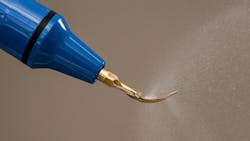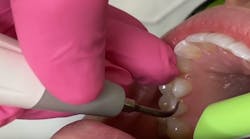Using the proper ultrasonic technique makes all the difference
The ultrasonic scaler is a transformative instrument in the dental hygiene day, offering efficiency, precision, and comfort for practitioners and patients. Its ability to effectively remove calculus, biofilm, and stains makes it a key aspect of our instrumentation that we do every day and every hour in dental hygiene.
However, to harness its full potential, clinicians need to understand the proper techniques of this machine to make the most of our time, improve patient comfort, and prevent burnishing calculus. Do you remember your first day learning how to use the ultrasonic? It’s a bit overwhelming to monitor the patient, hold the suction, control the water and mist, and touch and adapt to the tooth to remove anything. But practice and understanding how the ultrasonic works will make a world of difference for you and your patients.
We know ultrasonic scalers operate through high-frequency vibrations, typically ranging from 20,000 to 45,000 cycles per second: they’re fast! These vibrations break up calculus and disrupt biofilm. But with improper technique, these instruments can cause more issues and end up using more time in your appointment. What can be done to help?
Key components of proper ultrasonic scaling technique
Proper tip selection: You’ve seen the variety of instruments and ultrasonic inserts at dental conventions or online. There are hundreds of them with a variety of designs for different clinical scenarios and it can be overwhelming! Standard tips are ideal for supragingival scaling and heavy calculus removal, while thin or curved tips are suited for subgingival debridement and accessing deep pockets. Using the appropriate tip for the task enhances efficiency and reduces the risk of tissue trauma.
Correct grasp and fulcrum: A modified pen grasp provides the control and stability needed for effective scaling. Establishing a stable finger rest ensures precise movement and minimizes operator fatigue. Avoid gripping the handpiece too tightly as this can reduce tactile sensitivity and lead to discomfort for the patient and clinician.
Tip-to-tooth adaptation: Proper adaptation of the tip to the tooth surface is crucial. The lateral sides of the tip with only 2 to 3 mm should make contact with the tooth. Using the tip point can cause discomfort and potentially damage the enamel. Maintain an angulation close to parallel with the tooth surface, typically no more than 15 degrees, to optimize effectiveness and minimize harm.
Efficient stroke techniques: Employ short, overlapping, methodical strokes to thoroughly cover the area being treated. These strokes can be linear, circular, or oblique, depending on the area and type of deposit being removed. Avoid pressure, as the ultrasonic scaler vibrations do the heavy lifting. Gentle strokes ensure patient comfort and prolong the life of the insert.
Water flow and irrigation: Ultrasonic scalers rely on a steady flow of water to cool the tip and flush away debris. The water flow should produce a fine mist with visible droplets. Insufficient water can lead to overheating, while excessive flow may hinder visibility and patient comfort. No one has time to constantly be suctioning water from patients.
Patient positioning and comfort: Position the patient in a reclined position with their head turned to provide optimal access to the treatment area. Use high-volume suction to manage water accumulation and prevent gagging or aspiration. Clear communication with the patient throughout the procedure helps alleviate anxiety and ensure a positive experience.
Focusing on channeling technique
When removing calculus and biofilm with an ultrasonic, covering each section of the tooth is key to proper removal and healing. To make sure you cover every square millimeter of the root, both above and below the gingiva, it’s important to perform a channelling technique. This technique will methodically cover all aspects of the tooth and ensure more removal of calculus and biofilm.
Enhancing clinical outcomes
Looking for a way to help improve your ultrasonic technique? Videos can help. Watching clinicians perform the skills is extremely eye opening, just like this video from Hygiene Edge about channeling. See channeling in action, and how important the proper technique is for calculus removal.
The ultrasonic is an invaluable asset in our dental hygiene arsenal to offer the best and most comfortable care for patients. Mastering its proper technique requires attention to detail, a commitment to practice, and patience with yourself as you learn. You’re in the perfect place to learn and grow, and I’m proud of you as you go through this dental hygiene education and ultrasonic journey.
About the Author

Melia Lewis, MEd, RDH
Melia Lewis, MEd, RDH, graduated in 2009 and has been working clinically or as an adjunct professor in Canada and the US. She is cofounder of Hygiene Edge, an online education platform full of tips and tricks to make dental professionals' lives easier. She has a passion for education and empowering dental hygienists to be their best. When she’s not talking dentistry, she’s planning her next trip. She has of two daughters and loves being in the mountains with her family. Contact her at [email protected] or on Instagram @hygieneedge and @meliardh.


